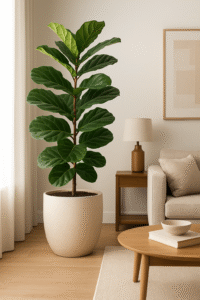Taking care of houseplants goes far beyond watering them at the right time or placing them in a decorative pot. The soil you use plays one of the most crucial roles in their overall health, growth, and beauty. Choosing the wrong type of soil can lead to poor development, root rot, nutrient deficiencies, and even plant death.
To ensure your indoor plants thrive, it’s essential to understand what makes good soil and how to match it with your plant’s needs. Below, we highlight 5 key factors to consider when choosing soil for your houseplants.
1. Soil texture and drainage
One of the most common mistakes is using heavy, compacted soil. This type of soil prevents air circulation and makes it difficult for excess water to drain. Most houseplants require light, well-draining soil that allows roots to breathe while avoiding waterlogging.
-
Clay-heavy soils retain too much water, often leading to root rot.
-
Sandy soils, on the other hand, drain too quickly and fail to hold enough nutrients.
The ideal solution is a balanced substrate, usually made from organic matter (such as compost or worm castings) mixed with drainage enhancers like coarse sand, perlite, or pine bark. This balance provides moisture retention while ensuring oxygen reaches the roots.
2. Nutrient content
Soil must also provide essential nutrients for proper plant growth. The most important are the macronutrients:
-
Nitrogen (N): promotes lush, green foliage.
-
Phosphorus (P): supports root growth and flower development.
-
Potassium (K): strengthens plants and increases resistance to pests and diseases.
In addition, plants need micronutrients such as magnesium, calcium, iron, and zinc. If the soil is poor, regular fertilization will be required. Many ready-to-use houseplant mixes already contain slow-release fertilizers, which is especially helpful for beginners.
It’s also worth noting that different plants have unique nutritional needs. Ferns, for example, benefit from soil rich in organic matter, while orchids grow better in low-nutrient, airy substrates.
3. Soil pH level
The pH of the soil determines whether nutrients are available for the plant to absorb. Even if soil is nutrient-rich, an improper pH can prevent roots from accessing them.
Most houseplants thrive in slightly acidic to neutral soil, with a pH between 5.5 and 6.8. Within this range, nutrients are optimally available.
Simple testing kits can be purchased to check pH at home. If the soil is too acidic, adding lime can help balance it. If it is too alkaline, organic matter such as peat moss or composted leaves can be added to lower the pH.
4. Presence of organic matter
Organic matter is essential for healthy soil. It improves soil structure, increases water retention, and encourages beneficial microorganisms to thrive. These organisms help decompose material and make nutrients available to the plant.
Soil rich in organic matter is typically darker, loose, and has a pleasant earthy smell. For houseplants, amending the soil with worm castings, aged manure, or homemade compost can greatly improve its quality.
Not only does organic matter provide nutrients, but it also helps maintain soil aeration and moisture balance, both crucial for indoor plants that depend entirely on the substrate in their pots.
5. Compatibility with the type of plant
Finally, there is no such thing as “one soil fits all.” Each plant has specific soil requirements that should be respected:
-
Cacti and succulents: prefer sandy, fast-draining soil with very little moisture retention.
-
Ferns and tropical plants: need soil rich in organic matter with higher moisture retention.
-
Orchids: do not grow well in standard soil; they require special mixes like pine bark, charcoal, or coconut husk for proper aeration.
-
Herbs grown indoors (such as basil and rosemary): need fertile, well-draining soil with good exposure to sunlight.
For this reason, it’s important to always match the soil to the plant. Using the same mix for all species may compromise the health of some of your houseplants.
Conclusion
Choosing the right soil is one of the most important steps toward successful indoor gardening. By paying attention to texture and drainage, nutrient content, pH levels, organic matter, and plant-specific needs, you’ll be providing your houseplants with the foundation they require to grow strong, beautiful, and healthy.
Investing in quality soil is not an unnecessary expense—it is an investment in the health and longevity of your plants. A well-chosen substrate will help your plants thrive, making your home greener, fresher, and more welcoming.
Remember: soil is the base of everything. With the right choice, your houseplants will reward you with vibrant leaves, colorful flowers, and a more lively home environment.

🌱 Complete Your Gardening Experience
Transform your indoor and outdoor gardening with the 11-Piece Heavy-Duty Garden Tool Set.
Designed with ergonomic handles, durable rust-proof aluminum tools, and a practical tote bag for easy storage,
this set is perfect for beginners and experienced gardeners alike.
A thoughtful gift for women, men, moms, and dads who love to nurture plants!

🌳 Discover More About the Jacaranda Tree
The Jacaranda tree is admired worldwide for its stunning purple blooms and cultural importance.
Want to explore its fascinating facts, symbolism, and ecological role?
Continue reading and uncover everything about this extraordinary tree.

